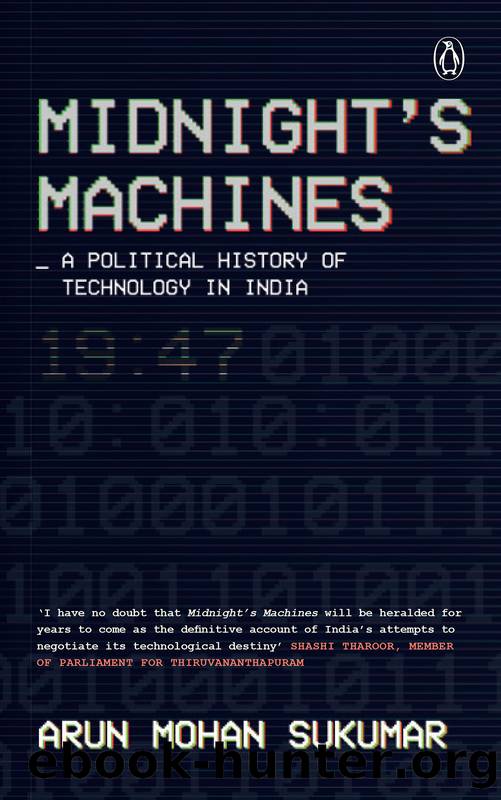Midnight's Machines by Arun Mohan Sukumar

Author:Arun Mohan Sukumar [Sukumar, Arun Mohan]
Language: eng
Format: epub
ISBN: 9789353057084
Publisher: Penguin Random House India Private Limited
Published: 2019-11-11T00:00:00+00:00
The Dawn of Big Data
âTaking a new step, uttering a new word is what men fear the most.â
âFyodor Dostoevsky, Crime and Punishment
In 1995, two young PhD students ran into each other at Stanford, and created an application called âBackRubâ that could trawl and index all content on the web. Their story is the stuff of legend. Less well-known is the tale, from 1983, of a frustrated Karnataka-cadre Indian Administrative Service (IAS) officer who decided to spend the funds allocated to him for a jeep on a computer instead. 46 Sanjoy Dasgupta, the special deputy commissioner at Karwar, a coastal district, had had it with taking âarbitrary decisions based on unorganized informationâ. 47 Locating and pulling out records from the block, district and state levels had become an impossible task. Most of the data Dasgupta sought was manually gathered and fed into their byzantine administrative machinery, from which it never re-emerged. With the computer he purchasedâhis wife recalls the machine being installed amid the breaking of coconuts and incantations by pujaris 48âDasgupta computerized land records, loan reports and monitored the progress of village development projects. Through the âKarwar experimentâ, 49 as he called it, big data was born in India.
The curation of vast troves of information through digital networks did not begin with âBackRubâ, or Google, as it is known today. Even in the United States, the origin of big data is attributed to the adoption of the Social Security Number (SSN) by its Internal Revenue Service in the sixties, and the subsequent linking by credit-reporting agencies of the SSN to a personâs financial history. 50 But the computer programme developed at Stanford by Larry Page and Sergey Brin was the first successful effort at combing sources of data that, when put together, were capable of unearthing broad trends and patterns otherwise invisible to the naked eye. When Page and Brin brought Google to the world in 1998, four web âcrawlersâ (bot programmes) were sufficient to map the roughly 500 million web pages in existence at the time. 51 Today, Googleâs products aloneâMaps, Google+, Chrome, etc.âcreate data sets that are many times the size of the entire Internet in the nineties. Still, the fact remains that the first âGooglersâ had something to work with. Google was created exactly three decades after the engineer Doug Engelbart wowed his Bay Area audience with the âmother of all demosâ, introducing them to the modern personal computer (PC). 52 Its popularity in the United Statesâa third of American households had a PC by the early nineties 53âhad since made possible the creation of a treasure chest of information, which the search engine farmed effectively.
A civil servant in India of the eighties, Sanjoy Dasgupta had no such luxury. The Internet as it existed in the US was all but unknown in the country. There were no digitized databases and no networks to connect them. Even if such a network could be created, India had few micro-computers and fewer individuals willing to feed them data! The bulk
Download
This site does not store any files on its server. We only index and link to content provided by other sites. Please contact the content providers to delete copyright contents if any and email us, we'll remove relevant links or contents immediately.
Anxious People by Fredrik Backman(2508)
The Last Thing He Told Me by Laura Dave(2163)
The Soulmate Equation by Christina Lauren(1886)
Not a Happy Family by Shari Lapena(1555)
Romancing Mr. Bridgerton (Bridgerton 04) by Julia Quinn(1500)
Slough House by Mick Herron(1386)
Life's Too Short by Abby Jimenez(1371)
The Switch by Beth O'Leary(1364)
Kiss My Cupcake by Helena Hunting(1321)
Solutions and Other Problems by Allie Brosh(1293)
Mordew by Alex Pheby(1246)
This Time Next Year by Sophie Cousens(1173)
A Rogue of One's Own by Evie Dunmore(1093)
No One Is Talking About This by Patricia Lockwood(1057)
The Mary Shelley Club by Goldy Moldavsky(1036)
Playing Nice by JP Delaney(1019)
Roadside Picnic by Arkadi & Boris Strugatsky(991)
Squeeze Me: A Novel by Carl Hiaasen(986)
Quinoterapia by Quino(976)
